Sailor's Luck Cardigan |
|
 |
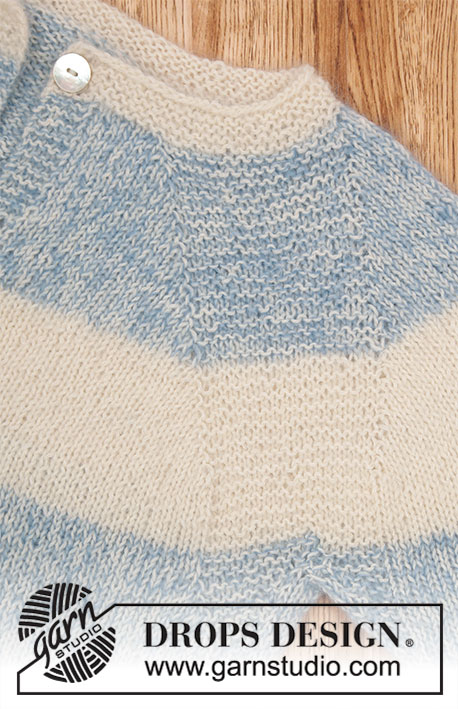 |
Knitted jacket with raglan and stripes, worked top down. Sizes S - XXXL. The piece is worked in DROPS Nord and DROPS Kid-Silk.
DROPS 191-27 |
|
|
INFORMATION FOR THE PATTERN: RIDGE/GARTER STITCH (worked in the round): 1 ridge = 2 rounds. Knit 1 round and purl 1 round. RIDGE/GARTER STITCH (worked back and forth): 1 ridge = Knit 2 rows. INCREASE TIP-1 (evenly spaced): To work out how to increase evenly, count the total number of stitches on the needle (e.g. 92 stitches) minus the bands (e.g. 10 stitches) and divide the remaining stitches by the number of increases to be made (e.g. 4) = 20.5. In this example, make 1 yarn over after alternately the 20th and 21st stitch. On the next row work the yarn overs twisted to avoid holes. INCREASE TIP-2 (for sides of body): All increases are made from the right side! Work until there are 2 stitches left before the marker thread, 1 yarn over, knit 4 stitches (the marker thread sits in the middle of these 4 stitches), 1 yarn over. On the next row purl the yarn overs twisted to avoid holes. Then work the new stitches in stockinette stitch STRIPES: 11-11-11-12-12-12 cm / 4½"-4½"-4½"-4¾"-4¾"-4¾" with 1 strand off-white Nord and 1 strand gray blue Kid-Silk. 11-11-11-12-12-12 cm / 4½"-4½"-4½"-4¾"-4¾"-4¾" with 1 strand off-white Nord and 1 strand off-white Kid-Silk. 11-11-11-12-12-12 cm / 4½"-4½"-4½"-4¾"-4¾"-4¾" with 1 strand off-white Nord and 1 strand gray blue Kid-Silk. Then work with 1 strand off-white Nord and 1 strand off-white Kid-Silk to finished length. RAGLAN: All increases are made from the right side! Increase 1 stitch on each side of the 16 stitches in garter stitch in each transition between body and sleeves (= 8 stitches increased on the row). Increase 1 stitch by making 1 yarn over. On the next row purl the yarn overs twisted to avoid holes. Then work the new stitches in stockinette stitch. DECREASE TIP (for sleeves): All decreases are made from the right side! Decrease 1 stitch on each side of the marker thread as follows: Work until there are 3 stitches left before the marker thread, knit 2 stitches together, knit 2 (the marker thread sits in the middle of these 2 stitches), slip 1 stitch as if to knit, knit 1, pass the slipped stitch over the knitted stitch. BUTTONHOLES: Work buttonholes on the right band (when the garment is worn). Work from the right side until there are 3 stitches left on the row as follows: Make 1 yarn over, knit 2 together and knit the last stitch. On the next row knit the yarn over to leave a hole. The first buttonhole is worked when the garter stitch edge in the neck measures approx. 2 cm / ¾". Then work the next 4 buttonholes with approx. 11-11-11-12-12-12 cm / 4½"-4½"-4½"-4¾"-4¾"-4¾" between each (= in the transition between each of the stripes + 1 buttonhole 11-11-11-12-12-12 cm / 4½"-4½"-4½"-4¾"-4¾"-4¾" after the last stripe). ---------------------------------------------------------- JACKET: The piece is worked back and forth on circular needle, top down. The sleeves are worked in the round with double pointed needles. YOKE: Cast on 92-95-98-101-107-112 stitches with circular needle size 4.5 mm / US 7 and 1 strand off-white Nord and 1 strand off-white Kid-Silk (= 2 strands). Purl 1 row from the wrong side, then work 3 RIDGES - see description above - remember BUTTONHOLES! Change to circular needle size 5 mm / US 8. Work 1 ridge where, on the first row, you increase 4-13-18-19-17-16 stitches evenly on row – read INCREASE TIP-1 (evenly spaced) = 96-108-116-120-124-128 stitches. Now work STRIPES – see description above, work pattern and increase to RAGLAN – see description above, from the right side as follows: 5 band stitches in garter stitch, 5-8-10-11-12-13 stitches in stockinette stitch (= left front piece), make 1 yarn over, 16 stitches in garter stitch (= raglan line), make 1 yarn over, 1 stitch in stockinette stitch (= sleeve), make 1 yarn over, 16 stitches in garter stitch (= raglan line), make 1 yarn over, 10-16-20-22-24-26 stitches in stockinette stitch (= back piece), make 1 yarn over, 16 stitches in garter stitch (= raglan line), make 1 yarn over, 1 stitch in stockinette stitch (= sleeve), make 1 yarn over, 16 stitches in garter stitch (= raglan line), make 1 yarn over, 5-8-10-11-12-13 stitches in stockinette stitch (= right front piece), 5 band stitches in garter stitch. The first increase to raglan is now finished (= 8 stitches increased on row). Continue back and forth in this way and increase to raglan every 2nd row a total of 21-23-25-27-30-32 times = 264-292-316-336-364-384 stitches. When all the increases to raglan are finished, the piece should measure 21-23-25-27-29-31 cm / 8¼"-9"-9¾"-10⅝"-11⅜"-12¼" from the cast-on edge measured down mid front. If the piece is shorter than this continue with pattern as before (without increasing number of stitches) until the piece has the right length. The next row from the right side is worked as follows (continue the pattern as before): Work 41-45-47-51-55-59 stitches (= left front piece), place the next 55-61-69-71-77-79 stitches on a thread (= sleeve), cast on 6-6-8-8-10-12 new stitches on the needle (= side under sleeve), work the next 72-80-84-92-100-108 stitches (= back piece), place the next 55-61-69-71-77-79 stitches on a thread (= sleeve), cast on 6-6-8-8-10-12 new stitches on the needle (= side under sleeve), work the remaining 41-45-47-51-55-59 stitches (= right front piece). BODY: = 166-182-194-210-230-250 stitches. THE PIECE IS NOW MEASURED FROM HERE! Insert a marker thread in each side (= middle of the new stitches cast on under each sleeve = 3-3-4-4-5-6 new stitches on each side of the marker thread). Continue back and forth with stockinette stitch and garter stitch over the 5 band stitches in each side towards mid front and over the 10-9-7-8-8-9 stitches which remain on the front and back pieces (from the garter stitch section along the raglan lines), AT THE SAME TIME on every 2nd row make 1 yarn over on the outside of each garter stitch section towards mid front and towards mid back (=a total of 4 stitches increased on row) and decrease 1 stitch in each garter stitch section by knitting the 2 outermost stitches in garter stitch section towards the side of garment together (= 1 stitch decreased in each garter stitch section towards the side, a total of 4 stitches decreased on row). NOTE! The number of stitches stays the same, but the stitches in garter stitch will gradually disappear and there will be more stitches in stocking stitch, (i.e.4 stitches increased and 4 stitches decreased on every 2nd row). When all the stitches in garter stitch are gone, continue with stockinette stitch and 5 band stitches in garter stitch in each side towards mid front, AT THE SAME TIME on the first row from the right side increase 1 stitch on each side of the marker threads in each side – read INCREASE TIP-2. Increase like this every 8-8-9-9-7-7 cm / 3"-3"-3½"-3½"-2¾"-2¾" a total of 4-4-4-4-5-5 times = 182-198-210-226-250-270 stitches. Continue working until the piece measures 36 cm / 14¼" in all sizes. Change to circular needle size 4.5 mm / US 7. Work garter stitch for 7 cm / 2¾". Bind off with knit from the right side. You can use a size larger needle to bind off to avoid the bind-off edge being tight. The piece measures approx. 66-68-70-72-74-76 cm / 26"-26¾"-27½"-28⅜"-29⅛"-30" from the shoulder down. SLEEVE: Place the 55-61-69-71-77-79 stitches from the thread on the one side of the piece on double pointed needles size 5 mm / US 8 and, in addition, cast on 6-6-8-8-10-12 new stitches mid under the sleeve = 61-67-77-79-87-91 stitches on the needle. Insert a marker thread in the middle of the new stitches – THE PIECE IS NOW MEASURED FROM HERE! Work stockinette stitch over stockinette stitch and garter stitch over garter stitch; at the same time decrease the stitches in garter stitch in the same way as on the body (the number of stitches stays the same). When the stitches in garter stitch have gone, work stockinette stitch over all stitches, at the same time on the first row decrease 2 stitches mid under the sleeve – read DECREASE TIP. Decrease like this approx. every 6-5-3-3-2-2 rounds a total of 12-13-18-18-20-22 times = 37-41-41-43-47-47 stitches. Continue with stockinette stitch in the round until the piece measures 37-35-34-32-30-29 cm / 14½"-13¾"-13½"-12½"-11¾"-11½". Change to double pointed needles size 4.5 mm / US 7. Work garter stitch for 5 cm / 2". Bind off with knit. You can use a size larger needle to bind off to avoid the bind-off edge being tight. The sleeve measures 42-40-39-37-35-34 cm / 16½"-15¾"-15¼"-14½"-13¾"-13½". Work the other sleeve in the same way. ASSEMBLY: Sew openings under the sleeves. Sew buttons onto left band. |
|
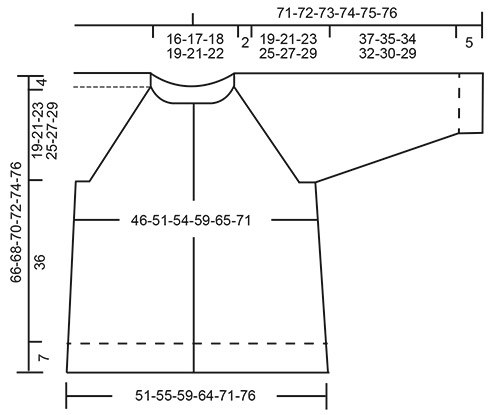
|
|
|
Have you made this or any other of our designs? Tag your pictures in social media with #dropsdesign so we can see them! Do you need help with this pattern?You'll find tutorial videos, a Comments/Questions area and more by visiting the pattern on garnstudio.com. © 1982-2024 DROPS Design A/S. We reserve all rights. This document, including all its sub-sections, has copyrights. Read more about what you can do with our patterns at the bottom of each pattern on our site. |
|










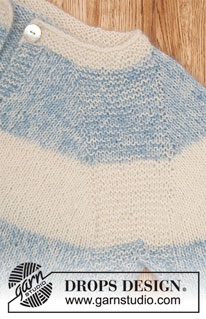
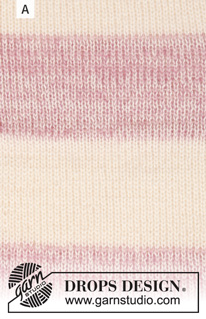
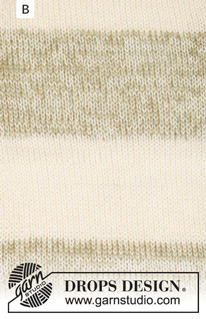


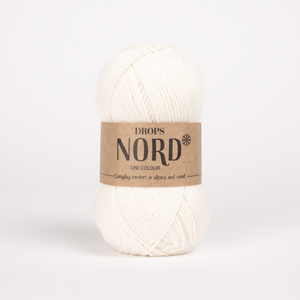
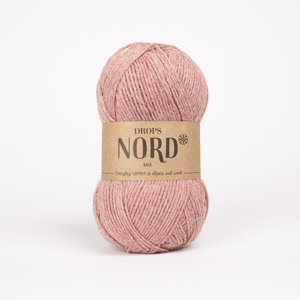
















































Comments / Questions (17)
Guten Tag, werden die unter den Ärmeln neu angeschlagenen Maschen ebenfalls kraus rechts gestrickt?
08.04.2024 - 16:33DROPS Design answered:
Liebe Frau Grohman-Kraus, die neu angeschlagenen Maschen werden glatt rechts gestrickt, die kraus rechte Maschen werden nach und nach abgenommen bis alle Maschen glatt rechts gestrickt sind. Viel Spaß beim Stricken!
09.04.2024 - 08:31Lisäysvikki 2. Norjalaisessa ohjeessa kerrotaan että neulo kunnes jäljellä 2 silmukkaa merkkilankaan. Suomenkielisessä 4 silmukkaa joka mielestäni on väärin.
06.09.2022 - 14:18Hej! Undrar om de 6 nya maskorna under ärmarna ska stickas i rät- eller slätstickning? Blir snyggare om de stickas i rätstickning då det blir en slätstickning kil på både body och ärm om jag tänker rätt. Hälsningar Gunilla Wiese
23.09.2021 - 15:07DROPS Design answered:
Hej Gunilla. Ja, de stickas i slätstickning. Mvh DROPS Design
24.09.2021 - 09:04Hallo, habe die Jacke genau nach Anleitung gestrickt. Doch es irriertiert mich ich das ich am Anfang, wenn ich die Raglanzunahmen 8x gearbeitet habe und in der nächsten Hinreihe beim rechten Vorderteil wieder einen Umschlag machen muss, so ergibt die Arbeit zwei verschiedene Vorderteile. Das eine linke Vorderteil hat 12 Maschen und das rechte inzwischen schon 30 Maschen. Ist das so korrekt ? Liebe Grüße Anja
18.02.2021 - 11:28DROPS Design answered:
Liebe Anja und Verzeihung für die verspäte Antwort, Ihre Frage wurde leider übersehen. Ich habe gerade alle Größe geprüft und habe die selbe Mascheanahl für beide Vorderteile: 5 BlendeMaschen + 5-8-10-11-12-13 = 10-13-15-16-17-18 Maschen insgesamt. Die Raglanzunahmen werden dann beidseitig von den 16 Maschen kraus rechts gestrickt. Wenn Sie nicht weiter könnten, stellen Sie bitte gerne Ihre Frage wieder, schreiben Sie uns vielleicht auch kurz mal die Größe. Danke im voraus!
26.04.2021 - 14:38Ytterligare en fråga då jag tycker mönstret 191 27 är lite svårt o förstå. Fram- och bakstycke: Gör jag ökning av 4 maskor o minskning av 4 maskor tills rätstickningen försvunnit o när det är klart påbörjar ökning som ska ske i mitt fall 4 gånger med 9 cm mellanrum. Eller sker dessa två saker samtidigt???
21.09.2020 - 14:00DROPS Design answered:
Hej Maria. Det ser ut som om det ska ske samtidigt enligt mönstret. Mvh DROPS Design
24.09.2020 - 11:49Hej! Vid ökning omslag o på avigt varv stickas vriden avig. Ska omslaget vridas åt olika håll? Tycker intagningarna blir större på ena sidan av de 16 m dvs varannan intagninslinje är snygg o de andra mer glesa. Går tyvärr inte o infoga foto här.
08.09.2020 - 12:21DROPS Design answered:
Hej Maria, der vil altid være lidt forskel, vi har strikket omslaget ens på begge sider. Man kan prøve at lave omslaget lidt stramt, eller så går det selvfølgelig at vride det den anden vej. Vi synes ikke forskellen er så stor at man er nødt til det. ... Men det er jo en smagssag så man gør som man vil. God fornøjelse1
09.09.2020 - 14:45Buongiorno, nella descrizione dello sprone si parla di gruppi di 16 maglia a maglia rasata, mentre nei suggerimenti per il raglan sono indicate 16 maglie a legaccio, come si vede anche dal particolare nella foto. Chiedo inoltre consiglio su come effettuare il cambio di colore.
14.04.2020 - 14:20DROPS Design answered:
Buongiorno Lucia, abbiamo corretto il testo, le 16 maglie sullo sprone si lavorano a maglia legaccio. Buon lavoro!
14.04.2020 - 15:16Garnforbrug er slet ikke rigtigt!!! Jeg er færdig med ryg/forstykke og har 2 ngl kid-silk tilbage i hvid, 2 ngl nord og intet kid-silk i blå. Mgl så stadig begge ærmer. Og kan ikke længere få den samme indfarvning. Garnforbrug bør rettes!!!!
03.01.2020 - 11:14Förstår inte att ärmen skal vara kortare på de större storlekarna än de små. Fel?
06.10.2019 - 01:15DROPS Design answered:
Hei Sigurveig. Man har ikke lengre ermer selv om man må ha en stor størrelse. Det er kortere mål i de større størrelsene pga bredere skuldervidde og lengre ermetopp). Mvh DROPS design
07.10.2019 - 10:41Bonjour, Je ne comprends pas le début, vous dites de faire un rang envers sur l'envers, et ensuite 3 côtes mousse, ce qui fait que l'on tricote 1 rg envers sur l'envers, puis ensuite 1 rg endroit sur l'endroit (mais là on obtient un jersey endroit sur l'endroit), ensuite bien sur on obtiendra un point mousse car tous les rangs seront à l'endroit. Y a t'il une erreur? Merci pour votre réponse. Cordialement. Annie Mével.
15.06.2019 - 19:58DROPS Design answered:
Bonjour Mme Mevel, le tout premier rang se tricote en jersey envers (= à l'envers sur l'envers), le rang suivant sera donc l'endroit et se tricotera à l'endroit (= 1er rang des 3 côtes mousse), On tricote ensuite encore 1 côte mousse (= 2 rangs endroit) en répartissant des augmentations), le dernier rang est sur l'envers et on continue ensuite sur l'endroit en commençant à augmenter pour le raglan. Bon tricot!
17.06.2019 - 07:50